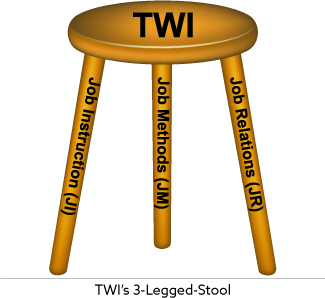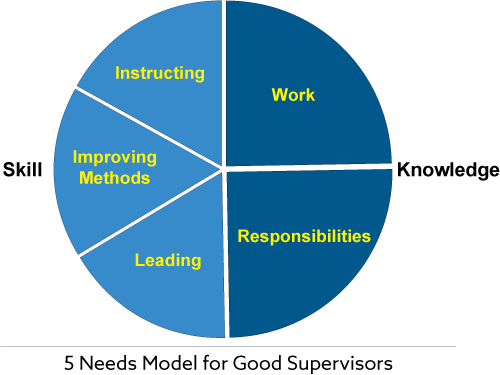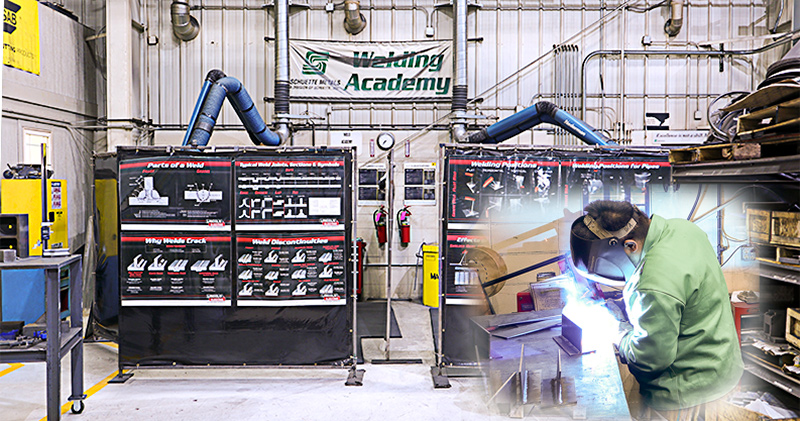Give a man a fish, and he will eat for a day. Teach a man how to fish, and you feed him for a lifetime. This saying shows the benefits of teaching a skill rather than showing it. (Unless, of course, that person is me – I'll catch a fish on my third cast, then get skunked the rest of the day. Thank goodness for grocery stores!)
 The theory behind the saying is people learn a skill better by doing it instead of watching somebody else do it. Think of tying a complicated knot. We watch somebody finish the knot in seconds, but when we try doing it, our success rate isn't as high as the pros. When we practice tying the knot repeatedly over time, our chances of succeeding improve exponentially.
The theory behind the saying is people learn a skill better by doing it instead of watching somebody else do it. Think of tying a complicated knot. We watch somebody finish the knot in seconds, but when we try doing it, our success rate isn't as high as the pros. When we practice tying the knot repeatedly over time, our chances of succeeding improve exponentially.
How much greater success? Until recently, this statistic was a subjective guess. The advent of Training Within Industry (TWI) proves just how effective this process is.
Training Within Industry

For good or bad, some of the most important advances in theory and technology occurred as a result of World War II. When Nazi Germany invaded France in 1940, planners in the United States realized any military build-up created a massive drop in available workers. Thus, the Bureau of Training War Manpower Commission was formed. Such a significant change in working demographics creates a vacuum, so to fill that vacuum, people who never worked in industry needed to step up and continue production.
Rosie the Riveter
The creation of TWI programs was aimed at women and some men who were too young to be drafted into the military. During the war, nearly 19 million women worked in various jobs in the US.
Interestingly, Naomi Parker Fraley was the real-life inspiration of the ubiquitous Rose the Riveter poster. She was 20 years old in 1942, working in a machine shop in California when she was photographed. In the photo,
In the photo, released through the Acme photo agency, she's bent over an industrial machine, wearing a jumpsuit and sensible heels, with her hair tied back in a polka-dot bandanna for safety.
This photo was the impetus behind the Rosie wartime poster. Ms. Fraley passed away in January 2018.
Training the Trainer
Initially, the goals of the TWI program were the rapid development of new staff for increasing quality, occupational safety, and production. TWI developed three managerial skills:
- the ability to instruct employees
- the ability to improve working methods (Kaizen)
- the ability to build good relations with employees (sometimes described as the ability of leadership
The TWI program was designed for experienced employees, and not to new employees. The assumption of the program was that every experienced employee (leader, manager) possesses knowledge about the work and scope of responsibilities, which is gained through practice for years. In contrast, the three key management skills must be developed. This program provides ready-made tools which support the management of employees by their superiors.
TWI's Success During the War
The results of the US TWI program were very impressive. According to Leantrix.com, out of the 600 manufacturing companies participating in the program during WWII:
- 100% of companies shortened the time of training new employees by 25% or more,86% of companies increased their efficiency by 25% or more
- 88% of companies reduced the workload on a product by 25% or more
- 55% of companies reduced deficiencies by more than 25%
- 100% of companies reduced complaints by more than 25%
After World War II
 During the war, Allied forces bombed Japanese cities, particularly the industrial areas, into rubble. Once the war ended, The USA immediately began assisting Japanese rebuilding efforts. One portion of the assistance was the TWI program, which Japan fully embraced. Training Within Industry became a vital component of the Toyota Production System (TPS). The TPS approach is to go to the source, observe in detail, and learn by doing – the foundation of the standardization philosophy of Toyota.
During the war, Allied forces bombed Japanese cities, particularly the industrial areas, into rubble. Once the war ended, The USA immediately began assisting Japanese rebuilding efforts. One portion of the assistance was the TWI program, which Japan fully embraced. Training Within Industry became a vital component of the Toyota Production System (TPS). The TPS approach is to go to the source, observe in detail, and learn by doing – the foundation of the standardization philosophy of Toyota.
Unfortunately, in the United States, TWI was put aside, and our industrial complex fell back into old habits. In his book, Training Within Industry: The Foundation of Lean, Donald Dinero, provides a few reasons why TWI didn't continue after the war:
First, he notes that the US was the world's economic powerhouse at the time (with the manufacturing base of many other countries destroyed by the way) and so simply wasn't focused on increasing efficiency after WWII. Second, he suggests that at individual American companies where TWI had already been installed, changes were made here and there to the TWI training methods after the government TWI agency had been disbanded at the war's end, leading to less effective results.
Dinero wrote that the Japanese embraced TWI and are still using the program. He said the Japanese Labor Ministry controls the use of TWI by administering programs and licensing other organizations for conducting J Courses.
What are J courses? I'm glad you asked.
TWI Structure
 Training Within Industry is a crucial part of Lean Management and focused on eliminating the root causes of human errors. The best way of removing those errors is to standardize training using TWI job instruction (JI).
Training Within Industry is a crucial part of Lean Management and focused on eliminating the root causes of human errors. The best way of removing those errors is to standardize training using TWI job instruction (JI).
TWI J courses consist of:
- Job Instruction Training (JI): the most popular of the J-Programs. Teaches supervisors how to quickly train employees to do a job;
- Job Methods Training (JM): Teaches supervisors how to continuously improve the way jobs are done
- Job Relations Training (JR): Teaches supervisors how to evaluate and take proper actions to handle and to prevent people problems
There are seven primary benefits of implementing TWI and J Courses:
- Getting more done with less equipment and manpower
- Improving quality, reducing errors by achieving standard work across workers and shifts
- Reducing safety incidents
- Decreasing training time, especially for temporary workers
- Reducing labor hours
- Reducing grievances
- Transferring of knowledge from a skilled workforce to an unskilled or green workforce
Even though TWI was used initially in the manufacturing sector, there are many other categories of businesses using the principles of TWI. Regardless of how it's used, applying TWI benefits people who are required to:
- train workers to perform a task
- build and maintain positive employee relations where people are treated as individuals yet work together as a team
- create a productive workplace environment, where jobs are performed the standard way by all operators every time
- improve the ways in which jobs are done
- ensure problem-solving is embedded in daily work and structured improvement
- embrace a proven approach to sustain continuous improvement
- And last but not least - improve safety in the workplace
 5 Needs of a Supervisor
5 Needs of a Supervisor
Using TWI principles, there are five crucial skills every supervisor should have. These skills include:
- Knowledge of the Work: This may relate to machines, tools, materials, operations, processes, or technical skills.
- Knowledge of Responsibilities: This may be policies, regulations, interdepartmental relationships, agreements, rules, schedules, and – very important – safety rules.
- Skill in Improving Methods: To utilize machines, manpower, and material more effectively. Nowadays, we would say to reduce waste (Muda).
- Skill in Instructing: To have a well-trained and effective workforce.
- Skill in Leading: Improve your ability to work with people to get the most out of the people you have.
Standardization
 Standardization occurs when a process is written down and continually improved. New workers are then trained using those standardized processes.
Standardization occurs when a process is written down and continually improved. New workers are then trained using those standardized processes.
By consistently using these processes, incidents of human errors drop. Dramatically. If somebody does make a mistake, the reason is narrowed to three possible root causes:
- The lack of or poor process of training operators.
- Failure to comply with a work standard by operators, due to the fact that the work standard was poorly developed.
- The lack of monitoring and auditing of an operator after training
Continuous Improvement
An organization converts solutions to problems by using standardization. Doing so, they continually improve their process. When that process doesn't improve, then attention needs to be directed towards what's being done – specifically if standard procedures are ignored or in error – or if there's a new influence affecting the process.
Continuous improvement needs the enthusiasm and support of the people running the TWI program. If engaged, those people end up being the leaders that train the trainers.
Schuette Welding Academy

Training Within Industry proves that on the job training in a controlled environment works. It's something we do, too. All new welders are required to complete the Schuette Welding Academy program – regardless of their welding experience.
Our academy ensures new welders aren't starting from scratch on our production line. Plus, new hires are trained using our standardization methods resulting in maintaining our high-quality standards. Our program also provides continuous training and advancement for employees.
In Sum
 Starting a new job without any training is akin to the phrase baptism by fire. You can receive all the verbal training possible, but when exposed to tasks for the first time, you don't have any practical experience to draw from.
Starting a new job without any training is akin to the phrase baptism by fire. You can receive all the verbal training possible, but when exposed to tasks for the first time, you don't have any practical experience to draw from.
We learned to tie our shoes from repetitive practice at home, so when our shoes became untied in public, we were prepared to take care of it.
The same theory holds when applying the Training Within Industry program. Preparing new hires by properly training them before they're exposed to the production line not only prevents mistakes because of lack of experience, but it also strengthens a person's confidence.